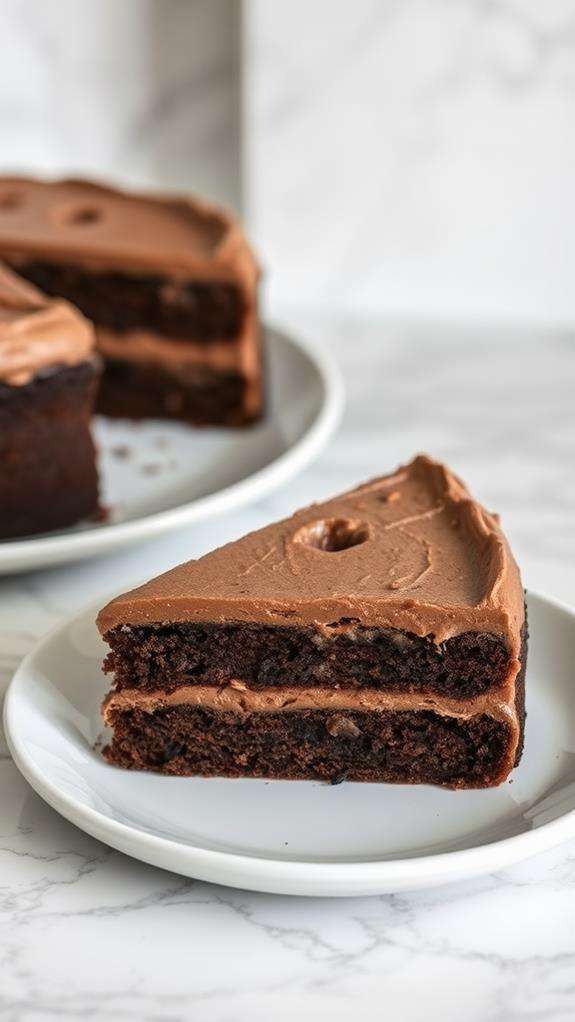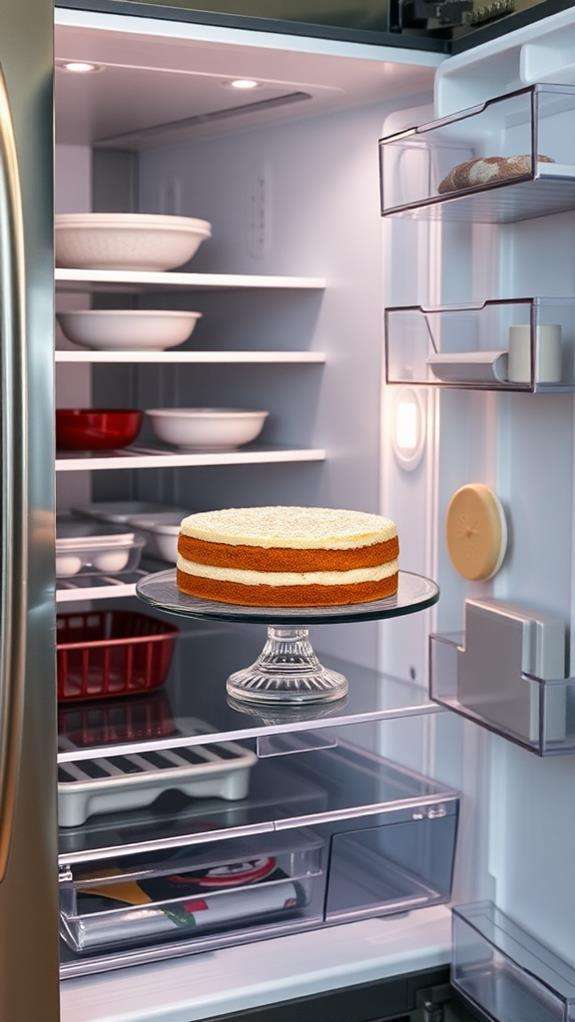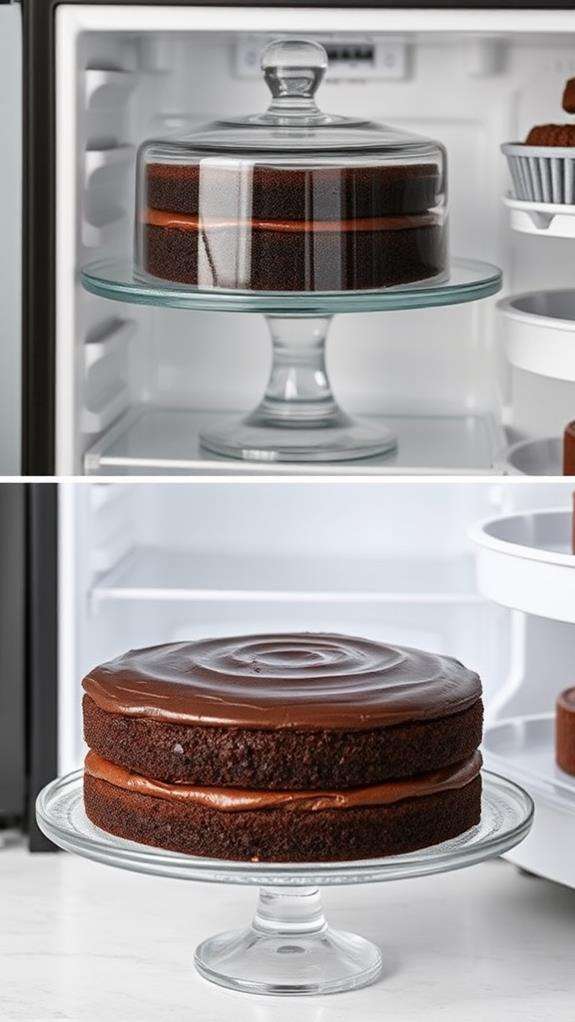How Long Does Cake Last in the Fridge
Your cake's refrigerator life depends on its ingredients and storage method. Basic sponge cakes last 5-7 days when stored properly in an airtight container, while cakes with cream cheese frosting should be consumed within 2-4 days due to their perishable ingredients. Fruit-filled cakes typically remain fresh for 3-5 days, with freshness varying based on the fruit's acidity and moisture content. You'll need to wrap your cake in plastic before placing it in an airtight container to prevent moisture loss and air exposure. Watch for signs of spoilage like mold, unusual odors, or texture changes. Understanding proper storage techniques can help you maximize your cake's freshness and safety.
This post may contain affiliate links. If you make a purchase through these links, I may earn a commission at no additional cost to you. Additionally, portions of this post may be generated using artificial intelligence (AI) technology. While we strive for accuracy, please be aware that AI-generated content may not always be perfect and should be fact-checked when necessary.
The Spatula Scoops
- Basic sponge cakes remain fresh for 5-7 days in the fridge when stored in an airtight container.
- Cakes with cream cheese frosting should be consumed within 2-4 days due to perishable ingredients.
- Fruit-filled cakes last 3-5 days in the refrigerator, with freshness varying based on fruit content.
- Unfrosted cakes can stay fresh up to a week in the fridge when properly wrapped and stored.
- Proper storage requires wrapping cake in plastic and using airtight containers before refrigerating.
Cake Storage Time Guidelines

Cake freshness depends heavily on storage conditions and ingredients. When you're looking to preserve your baked creations, understanding proper storage guidelines will help maintain their quality and prevent premature spoilage.
Your basic sponge cakes will stay fresh for 5 to 7 days in the fridge when you store them in an airtight container, making them one of the longer-lasting varieties. However, if you've got a cake with cream cheese frosting, you'll need to consume it within 2 to 4 days, as these perishable ingredients break down more quickly. For fruit-filled cakes, plan on a 3 to 5 day window of freshness, though this can vary based on the fruit's acidity and moisture content.
If you're storing your cake at room temperature, you'll want to eat it within 1 to 2 days. For ideal storage tips, always wrap your cake in plastic before placing it in an airtight container – this creates a barrier against moisture and air. Remember, cakes containing perishable ingredients like dairy-based frostings should go straight into the fridge to maintain food safety and quality.
Signs of Spoiled Cake

Knowing when to toss out your cake is essential for food safety. You'll need to watch for several clear signs that indicate your cake has passed its prime and shouldn't be consumed. The most obvious indicator is visible mold, which can appear as fuzzy spots on the surface of your cake, particularly in moist areas or around the frosting.
When you're examining your cake's freshness, trust your nose. If you detect a sour or musty smell, it's a reliable sign that your cake has started to spoil. You should also pay attention to texture changes, as cakes that have gone bad often develop a hardened exterior or become unusually soggy. Watch for any discoloration in both the cake's crumb and icing, as unexpected color changes can signal decomposition. While you might be tempted to taste the cake to check its quality, this isn't recommended if you've noticed any of the previous signs. However, if you do taste it and notice an off-flavor, that's a definitive indication that your cake has spoiled and should be discarded immediately.
Proper Refrigeration Methods

When storing your cake in the refrigerator, proper technique makes all the difference in preserving its freshness and flavor. To guarantee ideal cake storage, you'll need to wrap your cake tightly in plastic wrap or place it in an airtight container, which prevents moisture loss and protects it from absorbing unwanted flavors from other foods.
If you're refrigerating a frosted cake, it's crucial to chill it for 30 minutes before wrapping. This step allows the frosting to set, preventing it from sticking to the wrap and maintaining its appearance. When you place your cake in the fridge, choose a lower shelf where the temperature remains stable and exposure to air is minimal. You'll want to keep cake fresh by positioning it away from strong-smelling foods that could affect its delicate flavors.
Don't forget to label your cake with the storage date to track freshness effectively. This simple step helps you monitor how long the cake has been refrigerated and guarantees you'll consume it while it's still at its best. By following these proper refrigeration methods, you'll maintain your cake's quality and extend its shelf life considerably.
Room Temperature Vs Refrigeration

Understanding the difference between room temperature and refrigerated storage can greatly impact your cake's longevity and quality. When you're deciding how to store cake, consider its ingredients and composition to maximize freshness and prevent spoilage. For example, some cakes, particularly those high in sugar and fat, can retain moisture better, while others might dry out more quickly when stored improperly. Additionally, cakes with fresh ingredients may spoil faster due to their perishable nature and could benefit from proper washing before storage to prevent contamination.
You can safely keep basic butter-based cakes at room temperature for up to two days, provided you tightly wrap them or place them in an airtight container. However, if your cake contains perishable ingredients like whipped cream, cream cheese frosting, or fresh fruit, you'll need to refrigerate it. Refrigeration extends the shelf life to 3-7 days, protecting these sensitive components from bacterial growth.
While refrigeration offers longer preservation, it can lead to moisture loss in some cakes, potentially affecting their texture. To minimize this effect, you'll want to store cake in an airtight container and let it come to room temperature before serving. Remember that proper wrapping is essential regardless of your storage method. If you're dealing with a heavily filled or moisture-rich cake, opt for refrigeration even if it means sacrificing some textural qualities, as food safety should always be your primary concern.
Extending Your Cake's Shelf Life

To maximize your cake's shelf life, proper storage techniques and careful monitoring make all the difference. Storing your cake in an airtight container or wrapping it tightly with plastic wrap is essential for moisture preservation and protecting it from unwanted odors.
You'll need different storage approaches depending on your cake's ingredients. If you're keeping your cake with cream cheese frosting, it shouldn't stay at room temperature and needs refrigeration for up to four days. An unfrosted cake can last longer, typically up to a week when properly stored in the fridge. To store the cakes effectively, place them away from foods with strong aromas and avoid direct sunlight exposure, as these factors can compromise taste and freshness.
To extend your cake's shelf life, regularly check for spoilage signs including unusual odors, texture changes, or mold growth. If you're working with fruit-filled cakes, you'll need to be extra vigilant, as these varieties typically last only 3-5 days. Remember to seal your containers properly after each use, as repeated exposure to air can accelerate staleness and reduce your cake's longevity.
Frequently Asked Questions
Can Cake Last 2 Weeks in the Fridge?
No, you shouldn't keep cake in the fridge for 2 weeks, as it's beyond the safe storage period. While your cake might look okay, it'll likely be dried out and could harbor harmful bacteria. For best results, you'll want to consume refrigerated cake within 3-7 days, depending on its ingredients. If you've got cream cheese frosting or other perishable toppings, that window shrinks to 3-4 days. After that, you're risking both safety and quality.
Can You Eat a 2 Week Old Cake?
You shouldn't risk eating a 2-week-old cake, as it's past its prime and could make you feel under the weather. While your cake's been chilling in the fridge, it's been slowly losing its battle with freshness. Even if there's no visible mold, you're dealing with potential bacterial growth that you can't see. Instead of testing your luck, it's better to enjoy your cake within the first week of storage or freeze it for later enjoyment.
Is Cake Safe to Eat After 10 Days?
No, you shouldn't eat cake that's been stored for 10 days or longer. Even when refrigerated, most cakes develop harmful bacteria and mold after the 7-day mark. While you might not see visible signs of spoilage, the cake's quality and safety have likely deteriorated considerably. If your cake contains dairy-based ingredients like cream cheese frosting or custard filling, it's especially risky. For your safety, it's best to discard cake after a week.
How Long Will an Iced Sponge Cake Last?
Even though you'd love your iced sponge cake to last forever, it'll stay fresh for 3-5 days when properly stored in your fridge. If you're using cream cheese frosting, you'll want to enjoy it within 2-3 days. To maximize freshness, make sure you're storing it in an airtight container or wrapping it tightly in plastic wrap. You'll know it's gone bad if you spot any mold, notice odd smells, or detect changes in texture.





